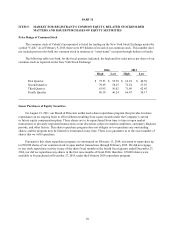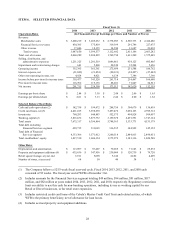Cabela's 2014 Annual Report Download - page 29
Download and view the complete annual report
Please find page 29 of the 2014 Cabela's annual report below. You can navigate through the pages in the report by either clicking on the pages listed below, or by using the keyword search tool below to find specific information within the annual report.19
x United States customs laws and regulations pertaining to proper item classification, quotas, payment
of duties and tariffs, and maintenance of documentation and internal control programs which relate to
importing taxidermy which we display in our retail stores.
Changes in these laws and regulations or additional regulation, particularly new laws or increased regulations
regarding sales and ownership of firearms and ammunition, could cause the demand for and sales of our products
to decrease and could materially adversely impact our revenue and profitability. Moreover, complying with
increased or changed regulations could cause our operating expenses to increase.
Our inability or failure to protect our intellectual property could have a negative impact on our
operating results.
Our trademarks, service marks, copyrights, patents, trade secrets, domain names, and other intellectual
property are valuable assets that are critical to our success. Effective trademark and other intellectual property
protection may not be available in every country in which our products are made available. The unauthorized
reproduction or other misappropriation of our intellectual property could diminish the value of our brands or
goodwill and cause a decline in our revenue. Any infringement or other intellectual property claim made against
us, whether or not it has merit, could be time-consuming, result in costly litigation, cause product delays, or require
us to enter into royalty or licensing agreements. As a result, any such claim could have a material adverse effect on
our operating results.
Risks Related to Our Financial Services Business
We may experience limited availability of financing or variation in funding costs for our Financial
Services segment, which could limit growth of the business and decrease our profitability.
Our Financial Services segment requires a significant amount of cash to operate. These cash requirements
will increase if our credit card originations increase or if our cardholders’ balances or spending increase.
Historically, we have relied upon external financing sources to fund these operations, and we intend to continue
to access external sources to fund our growth. A number of factors such as our financial results, changes within
our organization, disruptions in the capital markets, increased competition in the deposit markets, our corporate
and regulatory structure, interest rate fluctuations, general economic conditions, possible negative credit ratings
affecting our asset-backed securities, and accounting and regulatory changes and regulations could make such
financing more difficult or impossible to obtain or more expensive. In addition, several rules and regulations have
been proposed by the SEC that may substantially affect issuers of asset-backed securities.
We have been and will continue to be particularly reliant on funding from securitization transactions for
our Financial Services segment. Securitization funding sources include both variable funding facilities and fixed
and floating rate term securitizations. A failure to renew these facilities, to refinance the term securitizations
as they mature, or to add additional term securitizations and variable funding facilities on favorable terms as
it becomes necessary could increase our financing costs and potentially limit our ability to grow our Financial
Services segment. In addition, the ability of our Financial Services segment to engage in securitization transactions
on favorable terms or at all could be adversely affected by disruptions in the capital markets or other events,
which could adversely affect our business and cause our Financial Services segment to lose an important
source of funding.
In response to certain liquidity requirements recommended under the Basel Committee on Banking
Supervision in December 2010, commonly referred to as “Basel III,” the noteholders under one of the variable
funding facilities issued under WFB’s securitization program have requested and obtained amendments to their
respective transaction documents permitting them to delay funding an advance requested under that facility for up
to 35 days. It is not currently known what, if any, changes to their respective transaction documents the noteholders
under the other variable funding facilities issued under WFB’s securitization program will request in response to
























